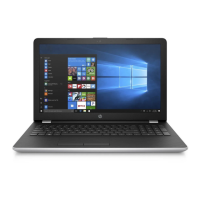
Do you have a question about the HP 15-bw0 Series and is the answer not in the manual?
Identifies and describes the components located on the right side of the computer.
Identifies and describes the components located on the left side of the computer.
Identifies and describes the components of the computer's display assembly.
Identifies and describes the keyboard and touchpad components.
Identifies and explains the function of status indicator lights on the keyboard.
Identifies and describes the computer's power button and its functions.
Identifies and explains the special keys on the keyboard, including Fn and Windows keys.
Explains the functions of various action keys that perform specific system tasks.
Identifies and describes the components located on the bottom of the computer.
Explains the purpose and location of service, regulatory, and wireless certification labels.
Provides an illustrated breakdown of the computer's major internal and external components.
Illustrates and lists spare parts for the display assembly, including bezel and panel.
Illustrates and lists spare parts for mass storage devices like optical drives and SSDs.
Illustrates and lists spare parts for various internal computer cables and their connectors.
Illustrates and lists spare parts for miscellaneous items like AC adapters and power cords.
Lists the essential tools needed to perform component removal and replacement procedures.
Provides essential considerations for safely handling components during disassembly and reassembly.
Offers precautions for handling plastic parts to prevent damage during service.
Provides guidance on carefully handling cables and connectors to avoid damage during service.
Details precautions for handling hard drives and optical drives to prevent damage or data loss.
Explains electrostatic discharge (ESD) risks and precautions to protect components.
Provides guidelines for properly packaging and transporting computer equipment.
Offers recommendations for setting up a safe and effective workstation for electronic repairs.
Recommends specific grounding equipment to prevent electrostatic damage to computer components.
Outlines the general steps and considerations for performing customer self-repair of computer parts.
Provides step-by-step instructions for removing and replacing the computer's battery.
Details the procedure for removing and replacing the computer's optical drive.
Provides instructions on how to remove and replace the computer's bottom cover.
Outlines general procedures and cautions for authorized service provider part replacement.
Details the removal and replacement of display bezel, panel, and camera/microphone module.
Provides instructions for removing and replacing the rubber feet on the computer.
Details the procedure for authorized service personnel to remove and replace the bottom cover.
Provides steps for removing and replacing the Wireless LAN (WLAN) module.
Details the procedure for removing and replacing the computer's memory modules (RAM).
Provides instructions for removing and replacing the optical drive connector board.
Details steps for removing and replacing the hard drive and its connector board.
Provides instructions for removing and replacing the M.2 SSD adapter bracket and connector board.
Details the procedure for removing and replacing the computer's solid-state drive (SSD).
Provides instructions for removing and replacing the Real-Time Clock (RTC) battery.
Details the procedure for removing and replacing the computer's speakers.
Provides instructions for removing and replacing the USB board.
Details the procedure for removing and replacing the computer's cooling fan.
Provides instructions for removing and replacing the heat sink assembly for thermal management.
Details the procedure for removing and replacing the TouchPad button board.
Provides instructions for removing and replacing the computer's system board (motherboard).
Details the procedure for removing the entire display assembly from the computer.
Provides instructions for removing and replacing the computer's power connector cable.
Details the procedure for removing and replacing the computer's power button board.
Illustrates the proper routing and location of various internal computer cables.
Provides instructions for removing and replacing the top cover and keyboard assembly.
Explains the steps to enter and start the computer's BIOS Setup Utility.
Provides information on how to obtain and install updated versions of the BIOS Setup Utility.
Guides users on how to identify the current BIOS version installed on the computer.
Details the process for downloading BIOS updates from the HP website.
Explains methods for creating system recovery media and personal data backups.
Details the procedure for creating HP-specific recovery media for system restoration.
Describes how to use built-in Windows tools for system restore points and data backups.
Outlines various options available for restoring and recovering the computer system.
Provides guidance on using HP Recovery Manager for system recovery procedures.
Lists important information and prerequisites before starting system recovery processes.
Explains how to change the computer's boot order to facilitate recovery media usage.
Details the process for removing the HP Recovery partition to free up disk space.
Provides instructions on how to initiate HP PC Hardware Diagnostics (UEFI) tests.
Guides users on downloading and creating HP PC Hardware Diagnostics (UEFI) on a USB device.
Introduces an additional tool for BIOS crisis recovery using an HP PC Hardware Diagnostics USB key.
Lists the general technical specifications for the computer, including dimensions and power.
Details the technical specifications of the 39.6-cm (15.6-in) display, such as resolution and brightness.
Provides detailed technical specifications for various hard drive capacities and types.
Lists the technical specifications for M.2 solid-state drives of different capacities.
Details the technical specifications for the DVD±RW SuperMulti DL optical drive.
Outlines the universal requirements applicable to all power cord sets used with the computer.
Lists specific power cord set requirements and certifications for various countries and regions.